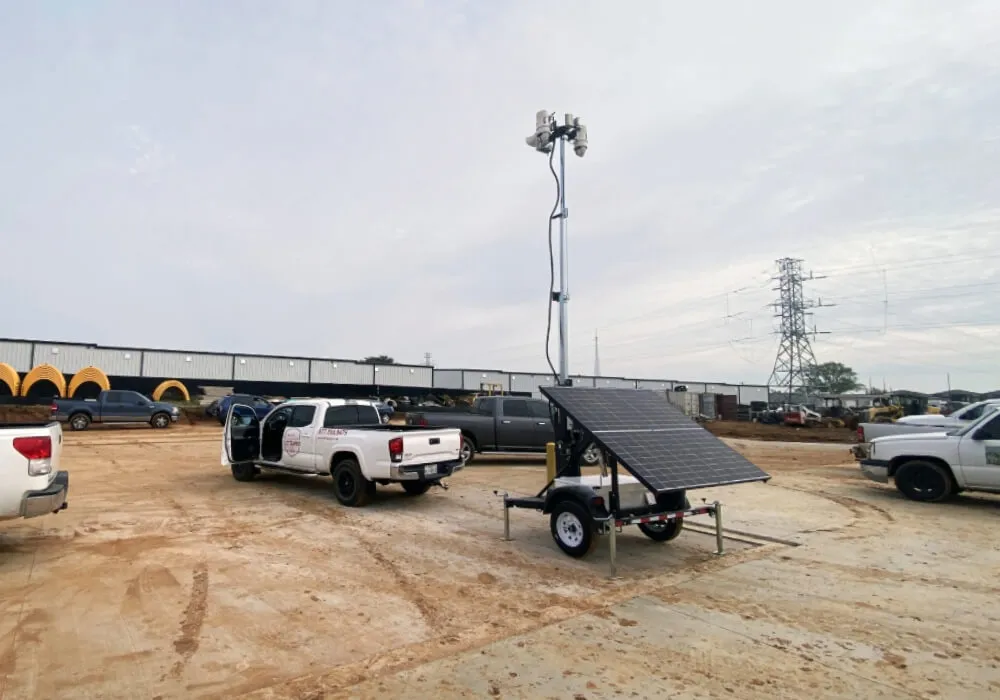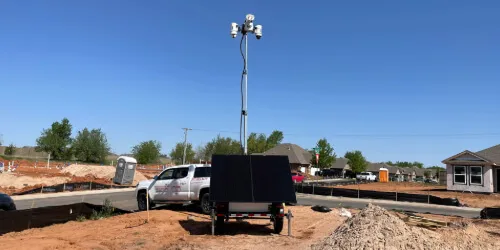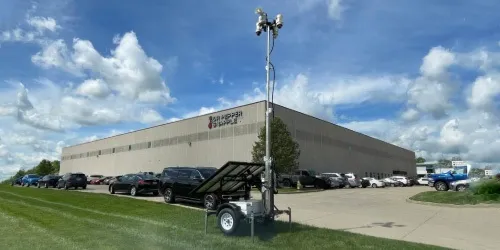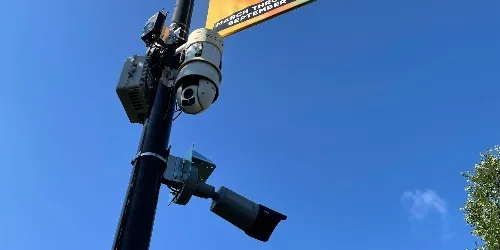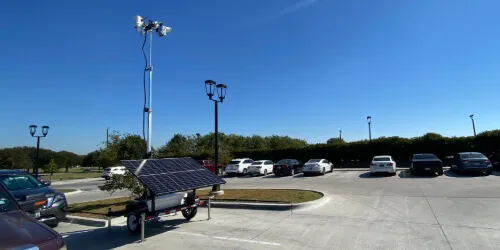Learn everything you need to know about solar-powered surveillance cameras in our comprehensive guide, including how they work and the benefits they provide.
Solar Surveillance Cameras: Your Complete Guide
Summer is on its way, bringing with it an abundance of sunlight and, unfortunately, a predicted rise in crime rates.
If you manage a construction job site, industrial property, or parking lot, or if you're planning a public event, now is the time to start thinking about security and researching the available options.
Solar surveillance cameras, including mobile solar surveillance trailers, are fast becoming the security solution of choice for a range of industries.
However, with a plethora of options available, how do you know which solution will provide the most reliable and budget-efficient performance?
The ultimate guide to solar surveillance cameras provides everything you need to know, from the benefits these systems deliver to how and where they should be deployed.
Want to make an informative decision about whether to use solar surveillance cameras? Then read on.
What Are Solar-Powered Surveillance Systems?
Solar-powered surveillance systems are surveillance cameras that utilize solar energy as their primary power source, making them ideal security solutions for locations without established power facilities.
The use of solar-powered cameras is increasingly driven by their convenience, cost-effectiveness, and their multiple environmental benefits.
The autonomous operation of a solar-powered security camera allows them to be quickly installed to provide temporary surveillance coverage in off-grid locations.
Key components of solar security cameras include:
- Solar Panels: Utilized to capture sunlight and convert it into energy to power the cameras
- Battery Storage: Most solar-powered surveillance units will have some form of battery backup power
- Security Cameras: Security cameras that capture high-quality, detailed footage day or night
- Wireless Connectivity: Wi-Fi or cellular-based connectivity that allows for remote access to real-time and stored video footage
They operate by using solar panels to harness sunlight and convert it into electricity, which is stored in batteries that can power the cameras on days when sunlight is not available.
The size and effectiveness of solar panels and batteries will vary by model, so it is worth doing further research on which solar camera is best for your location.
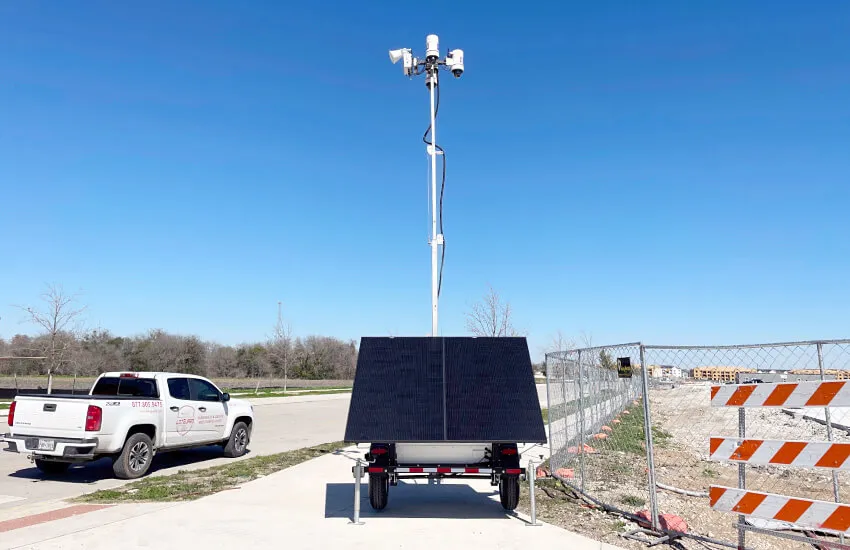
What are the Advantages of Solar-Powered Surveillance Cameras?
The growing popularity of solar-power surveillance cameras has been driven by the wide range of benefits they provide compared to traditional security camera systems.
We have previously explored in detail the benefits of mobile solar surveillance trailers, but to summarize our findings, they include the following:
Environmental benefits:
With many industries now recognizing the need to minimize how their business operations impact our physical environment, solar power security cameras are increasingly in demand for their many environmental benefits, such as:
- Zero-Emissions: Solar-powered security cameras remove the reliance on fossil fuel solutions, such as diesel generators, to power security setups, reducing an organization's overall carbon footprint.
- Non-disruptive: Solar-powered surveillance units are typically 'drop-and-go' solutions that require no disruption to the existing environment for installation or operation.
Lower Operating Costs:
At the same time as contributing to a cleaner environment, solar-powered surveillance cameras also have a positive effect on the bottom line by lowering the overall operating costs of a security setup. This is facilitated by:
- Fuel and Energy Costs: Solar is a free and renewable energy source that reduces energy bills by removing the need to run fuel-powered generators or rely on fixed electricity sources.
- Reduced Maintenance: Diesel-powered surveillance cameras require regular refuels, while fixed surveillance cameras require regular upkeep and ongoing checks. Solar-powered security cameras require almost zero maintenance by operating independently of power and internet sources.
Reliability:
When it comes to researching the best security solution, cost-effectiveness, and environmental benefits are worth absolutely nothing if the system isn't reliable. The vast majority of people would gladly pay more for a security setup so long as they knew it provided optimal performance at all times.
The dual benefit of solar-powered security cameras is that you don't have to pay a premium to get reliable surveillance coverage.
- Uninterrupted Power Supply: Solar-powered surveillance cameras generate their own renewable energy source, meaning they are unaffected by power outages.
- Weather Resistance: By their nature, solar power surveillance cameras are specifically designed for outdoor deployment and will be ruggedized to withstand any weather conditions.
Rapid Deployment and Relocatable:
Think of the major drawbacks of typical surveillance camera installations. They take a long time to install, may involve work permits, require specialist equipment and personnel, and can cost thousands of dollars.
After all that time and effort spent hooking up your surveillance cameras, what happens next? The criminal activity moves somewhere else, and now you're stuck with cameras that are completely worthless.
Solar cameras are designed to prevent this scenario and provide a dynamic, portable, and relocatable surveillance solution that is equally adapted to temporary security requirements as it is to longer-term crime deterrent applications.
- Flexibility: Solar cameras can be rapidly deployed to practically any location and easily repositioned to adapt to changes in site layouts, surveillance requirements, or priorities.
- Hassle-Free Setup: Save valuable man hours and installation costs with a simple plug-and-play setup process.
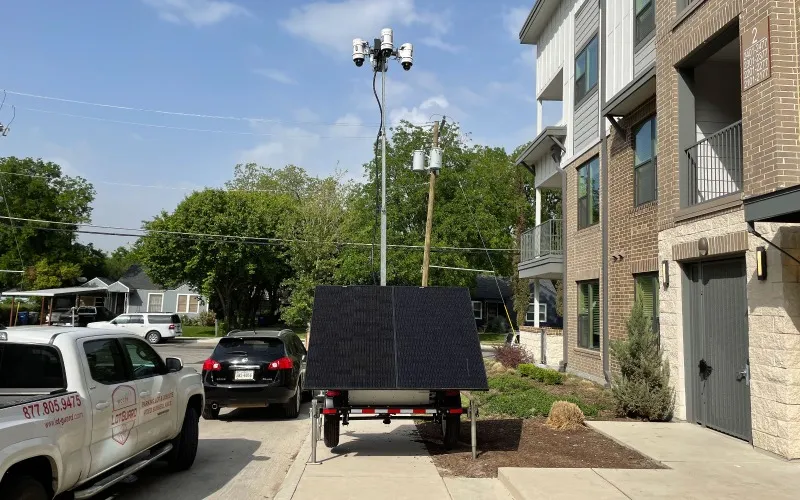
What are the Potential Drawbacks of Solar-Powered Surveillance Cameras?
Solar surveillance cameras offer multiple benefits to a wide range of industries, but they may not be suitable for every environment, and there are some potential limitations that you should consider prior to deployment
The majority of these limitations can be overcome either by utilizing the right technology or optimizing your deployment profile. Below, we outline some potential drawbacks of solar surveillance cameras and how these can be mitigated.
Space Requirements for Optimal Sunlight Exposure:
- Issue: When it comes to solar panels, typically, the bigger they are, the better they can draw in direct sunlight. This can make the deployment of solar-powered cameras challenging in environments where space is at a premium or where environmental factors prevent access to direct sunlight.
- Solution: With a wide range of solar-powered cameras available, finding a solution that works for your site's layout is far from impossible. From large mobile surveillance trailers to pole-mounted security cameras, there will typically be a solar-powered camera for any location.
Sunlight Variability:
- Issue: Unfortunately, not every day will be sunny, and not every location will be permissive of ongoing direct sunlight onto solar panels. Overcast days, obstructions such as buildings or trees, and seasonal changes can all affect the performance of a solar-powered surveillance camera.
- Solution: Deploying a system that has high capacity and reliable battery backup is critical to maintaining performance in times of poor weather conditions. Research some of the variable solar panel sizes and battery solutions to ensure you make the right choice of camera unit. In addition, ensuring that you face your solar panels in the right direction (typically due south in the northern hemisphere) and angle effectively will all help to maximize solar draw and performance.
Upfront Costs:
- Issue: If you are following a traditional purchase method, then investing in a high-specification solar surveillance unit, such as a mobile solar surveillance trailer, may have a higher initial cost than a standard security camera.
- Solution: Although the initial investment may be slightly steeper, the long-run cost-savings from increased operational efficiency, lower maintenance costs, and reduced power requirements mean that a solar surveillance camera will deliver longer-term cost savings. Additionally, you may wish to explore alternative procurement methods such as rental if you have a shorter-term surveillance need or leasing if you want to spread the cost.
Regular Upkeep:
- Issue: A solar surveillance unit will require significantly less upkeep than alternative security systems, but there are still elements that will need to be maintained. This includes keeping the solar panels clean, removing any dust or debris that may obstruct their ability to capture sunlight, and periodic checkups on battery performance.
- Solution: These maintenance needs will be significantly fewer than alternative solutions, and if you are renting your solar camera system, then your security partner will likely provide maintenance as part of their overall managed service.
Harsh Weather and Environmental Factors:
- Issue: Given the wide variety of solar-powered surveillance cameras now available in the marketplace, there are several budget-priced options. The danger with these cut-price systems is that they are typically manufactured overseas and do not consider the varying weather conditions of North America. This can lead to significant performance issues in areas where harsh weather, such as snow, rain, wind, and ice, is more prevalent.
- Solution: Ensure that you deploy a surveillance system that has been environmentally tested or rated for harsh environments. Where possible, utilize a solution manufactured in the USA, as these typically deliver high-quality performance in harsh weather.
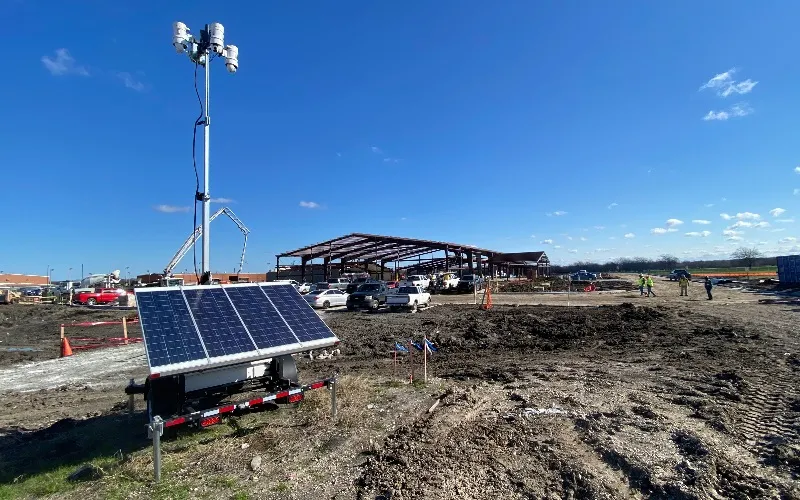
What Key Features Do Solar Surveillance Cameras Require?
Not all solar surveillance cameras are created equally, and as with any technology solution, there are high-spec, ultra-reliable solutions and cheaper, riskier options.
Understanding the requirements of your deployment scenario is the most important factor in deciding which key features your surveillance setup should deliver, but when it comes to solar-powered surveillance cameras, there are a number of non-negotiable features you should look out for.
Below, we have summarized the top seven features of solar-powered security cameras.
Backup Power Source
Why is it Important?: As we have highlighted above, not every day will be wall-to-wall sunshine, and as solar-powered cameras require direct sunlight for operation, the need for a robust backup solution is absolutely critical/
Key Feature to Look Out For: A solid, reliable, and high-capacity battery backup system that has been proven to work over long-term deployments. The last thing you need to be doing is hooking up additional generators or charging from mains power when your security cameras are supposed to be fully autonomous.
High Definition Cameras
Why is it Important?: Outdated and lower-resolution cameras will be unable to identify security threats at your location accurately, and the recorded footage they provide will be of too poor quality to effectively identify suspects and support investigations.
Key Feature to Look Out For: Only utilize solar surveillance cameras that offer HD video resolutions; look for 720p, 1080p, or 4K options. These camera systems will provide more accurate detection rates and ensure that all video footage recorded is usable in criminal investigations.
Battery Performance
Why is it Important?: Different models of solar surveillance cameras will have different recharge rates and battery durations. The faster your batteries can recharge and the longer they last, the more effective your surveillance system will be.
Key Feature to Look Out For: Seek out solar-powered camera units that have been specifically designed for optimal recharge rates and ones that contain high-capacity, long-lasting batteries. This will help mitigate against downtime and minimize your maintenance requirements.
PTZ Cameras
Why is it Important? A PTZ (or pan, tilt, and zoom) camera with a wide-angle lens will provide the most comprehensive coverage of your sites, ensuring no areas are out of the camera's reach.
Key Feature to Look Out For: Full 360-degree PTZ functionality that can be self-controlled and preset to provide a rolling 'tour' of your locations.
Night Vision and Low-Light Capabilities
Why is it Important?: Crimes such as construction site theft, auto theft, and commercial property theft are significantly more likely to occur at night. An effective surveillance camera setup must be able to detect activity and deliver clear imagery, no matter the lighting conditions.
Key Feature to Look Out For: Cameras with infrared (IR) capability deliver crystal-clear footage day or night. They can pick up key distinguishing features in areas with zero ambient lighting.
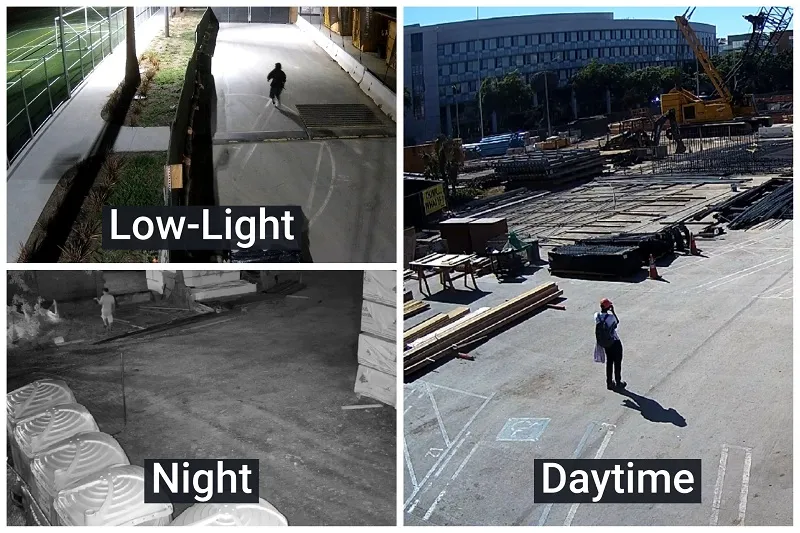
Remote Video Access
Why is it Important? One of the key benefits of any surveillance camera is being able to access the live and stored video footage that they provide. This allows continuous operation over time and the ability to react and respond to any events.
Key Feature to Look Out For: Always look for a camera setup that allows you to access video directly from a desktop software platform and/or mobile app. You should simultaneously be able to send video fees to a remote monitoring center that can provide 24/7/365 security services on your behalf. Don't settle for one or the other; demand both from your setup if needed.
Environmentally Tested
Why is it important?: Solar surveillance cameras will be deployed in outdoor environments year-round, exposing them to changing weather elements and potential extremes of heat, cold, rain, wind, snow, and ice. Units that have not been environmentally tested will suffer in these conditions and run the risk of complete failure.
Key Feature to Look Out For: Look for cameras that have been weatherproofed against dust and water, solar panels that are made from galvanized materials, and companies that are sealed and protected.
WCCTV - Next Generation Solar Surveillance Cameras
If you're ready to take the next step and integrate solar surveillance cameras into your security posture, then WCCTV's surveillance experts are ready to help you choose the best solution for you.
To get more information on our mobile solar surveillance trailers or pole-mounted cameras, just complete the short contact form below.
FAQs about Solar Surveillance Cameras
Are solar surveillance cameras worth it?
Whether or not solar surveillance cameras are worth it depends entirely on your viewpoint, deployment scenario, and objectives. Generally speaking, they are one of the smartest investments an organization can make when it comes to improving security, reducing its environmental impact, and securing long-term cost savings. Ultimately, if you have a security requirement at an off-grid location or need to bring surveillance to a location on a temporary basis, then solar surveillance cameras are absolutely worth it.
Can solar surveillance cameras operate in areas with frequent power outages?
Yes, solar surveillance cameras are ideal for areas with frequent power outages because they are designed to operate independently of the power grid. They utilize solar energy as their main power source and store energy in batteries to be utilized when there is no sun. For this reason, solar-powered cameras have become popular solutions for rapid deployment in areas affected by natural disasters.
Do solar surveillance cameras work at night?
Although solar surveillance cameras use direct sunlight for energy, they store energy harnessed during the day in batteries, which power them at night and on overcast days. A solar surveillance camera with IR capability is one of the most effective security solutions for nighttime operations.
